8 Reasons to Consider Consignment
When you’re looking to freshen your home décor, consignment shopping is an attractive option. But before making a foray into the consignment world, it helps to know the ins and outs of the process.

Her personality is as bright and perky as her shop. Photo: Charles Plohn
Enter Cynthia Johnson, who has a contagious enthusiasm in her mission to ensure that every piece of furniture is living its best life. Johnson, the owner of Elephant in the Room, a home furnishings consignment shop in Princeton, talks about home furnishings the way many people talk about puppies. There’s nothing better, she says, than when “the stars line up and a piece is ready to go to a home.”
I had a chance to chat with Cynthia, and she explained all the ways a good consignment shop benefits its clientele.
1. Consignment Can Help You Save Money
You can get high-quality items at a fraction of the cost. “It’s such a good way to get good deals on quality furniture,” Johnson says. “I typically price things at half of retail. The starting point is half of what [a previous owner] paid.”
2. Or Make Money
For the person who’s been thinking of simply discarding a sofa or table, any amount of money gained is a bonus. Potential consignors should be aware, however, that prices are reduced the longer a piece sits on the showroom floor. Johnson says she typically keeps pieces for about 90 days, marking them down in increments. “On day 30, the price is reduced by 15%. At day 60, it drops 30% off of the top price.” Still, Johnson has been known to extend that time if “it’s a great piece and it deserves a home.” (See what I mean?)
3. It’s On Trend
You’re most likely not going to find a hoard of chintz sofas and fringed lampshades in a good consignment shop. Johnson keeps her eye on the trends and does her best to stock currently popular styles. “I’m finding that people want a nice clean, streamlined look,” she says of her clients’ tastes.
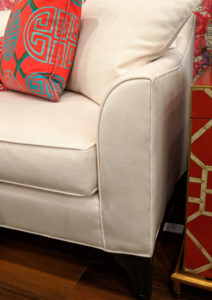
“Big roll arms on sofas and chairs are gone. Everyone wants a track arm,” Johnson says.
4. And Makes A Good Impression
Never underestimate the power of a professional, pretty environment when buying or selling goods — consignment is much more than an off-site garage sale. “I’ve got a showroom where I’m displaying things in their best light,” Johnson says. “It’s a nice environment, and I typically get better prices.” Consignment can also eliminate some of the hazards of selling pieces on your own. “You don’t have strangers come to your home.”
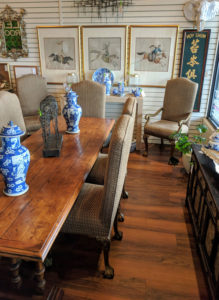
In the showroom, pieces are arranged the way they would be in a home.
5. Consignment Professionals Can Separate Trash From Treasures
Don’t think a consignment shop will take just any old thing; items must be in good condition to be considered. “I’m pretty picky about what I consign,” Johnson says, “because no one wants to do projects. They want to buy a piece, take it home and use it.”
Johnson’s exacting requirements extend to an issue that had been nagging at me throughout our conversation. What about bedbugs, fleas, etc.? (Ick.) Johnson is extremely careful about the items she takes in her shop. “Someone might have a spectacular leather sofa bed, but I don’t take sofa beds, no mattresses. I don’t even typically take upholstered headboards. I’m very picky about rugs as well. They can’t come from homes with pets.”
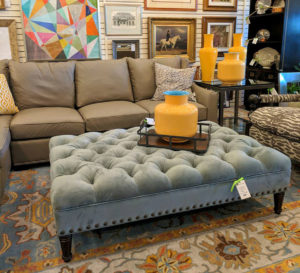
This carpet was fully vermin vetted before being accepted for consignment.
6. And Show You How To Mix And Match
Because you’ll most likely be blending existing or new pieces with consigned pieces, Johnson says, “I show people how to mix old and new.” In fact, new and consigned pieces share space on her showroom floor. (Johnson carries CR Laine, Wesley Hall, Harden, Cox Manufacturing, Modway and Thibaut, as well as her own textile collection in addition to consigned items.) “I might have a very traditional piece and mix it with funky pieces to show people how to do it successfully.”
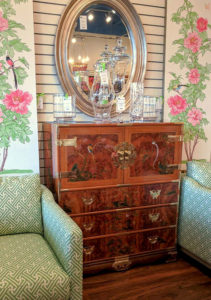
This vintage cabinet is displayed between two brand new chairs from CR Laine.
7. You Can Try Out Pieces You’re Interested In
Johnson encourages her clients to test out furnishings. “People shouldn’t be afraid to open drawers or sit on pieces,” Johnson says, to ensure that the items they’re buying will hold up in their home environment. For certain smaller pieces, Johnson goes a step further. “We occasionally allow people to take them home on approval,” she says, “if it seems necessary and reasonable” to get a feel for how a piece will work in a particular environment. (Customers sign an agreement and leave a credit card number before taking an item home for a few hours.)
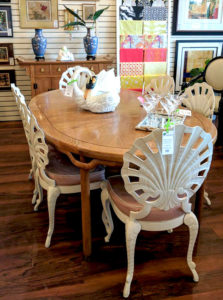
Not sure if a ceramic swan will work in your space? Take it home and see!
8. And Learn About Your Purchase
Johnson is a self-described “furniture geek” who loves talking with people. “Buyers shouldn’t be afraid to ask about the pieces,” she says. She talks to her consigners about the history of the pieces they’re selling and can point out to her customers “details you might not have thought about, such as dovetail joinery or quality construction. It’s about sharing the coolness of a piece.”
When Johnson researched the circa-1929 lamp below, for example, she found out some very cool things. “The figure is that of a real woman who, in 1920s Germany was hailed as the “Priestess of Depravity,” Anita Berber (androgynous cabaret dancer, alcoholic, drug addict). We were excited to find the black and white photo of Berber in this costume posing for the artist, C. Holzer Delfanti.”
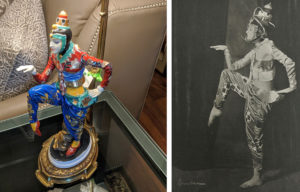
“It was one of those pieces that teeters between ugly and amazing!” Johnson says. Photo right: Wiener Museum of Decorative Arts
Cool pieces at good prices? It’s a win-win. “It’s so darn fun,” Johnson says. “I love to see the joy on clients’ faces when they discover something for their home.”
